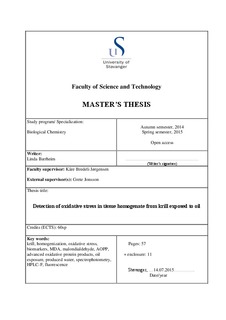| dc.description.abstract | Krill are small crustacean animals, living all over the world. They are key organisms in the marine food web. The petroleum industry releases oil to the sea with the produced water and by accidental oil spill, and there is a concern about the effect the oil has on krill. Discharges of oil can lead to a situation of oxidative stress in marine organisms. Biomarkers such as malondialdehyde (MDA) and advanced oxidative protein products (AOPP) can be used to detect oxidative stress.
Existing methods for homogenization, total protein content, AOPP and MDA were modified and validated for use on krill homogenate. The methods were then utilized to analyze krill from a study performed at the International Research Institute of Stavanger (IRIS), where krill had been exposed to sublethal oil concentrations for eight days. The experiments were performed in spring, autumn and winter to investigate potential seasonal variations in biomarker response.
The following results were obtained:
The homogenization process includes two successive centrifugation steps in order to get a clear and stable krill homogenate.
The krill homogenate had to be pre-diluted for the spectrophotometric methods to get an absorbance within the linear range of the calibrators (1:10 or 1:15 for total protein and 1:8.3 or 1:13.3 for AOPP).
Instrumental limits of detection and quantification for AOPP were 2.44 μM and 7.38 μM respectively, and the instrumental limit of quantification for MDA was 0.28 μM.
The within-run variations were 7.8% and 4.0-13% for plasma control and krill homogenate respectively for AOPP, and 19% for krill homogenate control for MDA.
Between-run variation was 8.8% for plasma control for AOPP, and 19% and 10% for krill homogenate control and plasma respectively for MDA.
AOPP and MDA levels were significantly higher in krill that were frozen directly after capture (T0) in spring and autumn compared to krill kept in the laboratory (T1).
Seasonal differences were detected with a significantly lower T1 MDA level in the spring krill, a significantly higher T0 MDA in autumn krill, and a significantly lower T0 AOPP in winter compared to T1 or T0 respectively of the other seasons.
Any effect of the oil exposure however was not observed with MDA or AOPP.
Three methods, AOPP, MDA and total protein, were successfully adjusted and validated for analysis of krill homogenate. Due to the good sensitivity of the methods, individual krill could be analyzed for both AOPP and MDA, and the concentrations normalized with respect total protein content. AOPP was a simple and fast method, and with higher precision than the MDA. An improved AOPP could be the method of choice for the future monitoring of oxidative stress level in krill. However, changes in AOPP or MDA levels due to oil treatment for eight days were not detectable due to a high natural variation of these biomarkers in the krill homogenate. | nb_NO |
